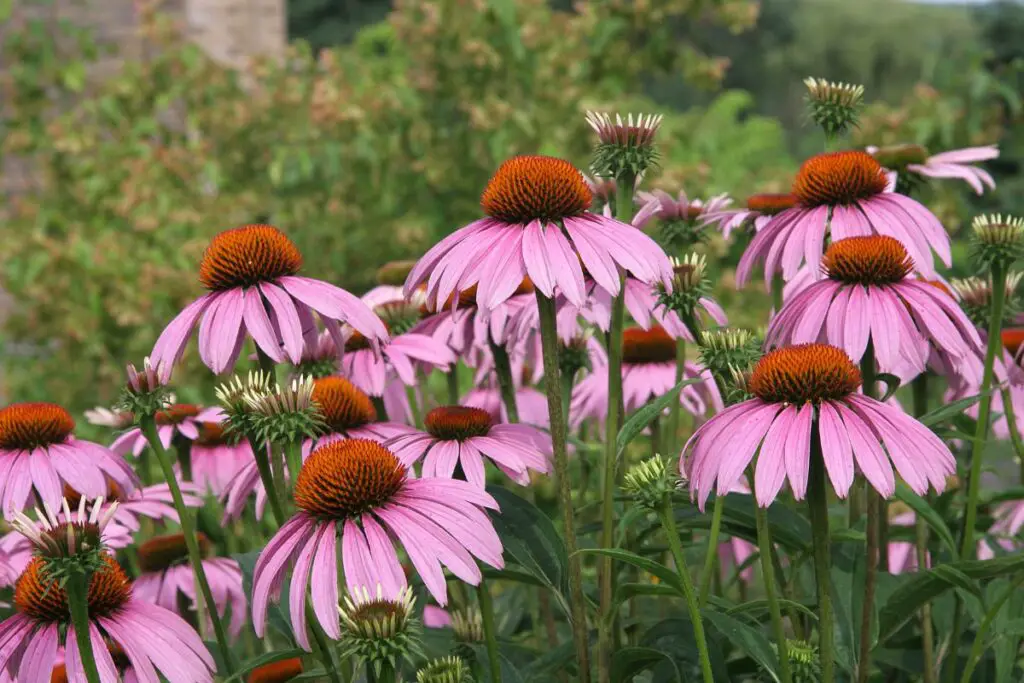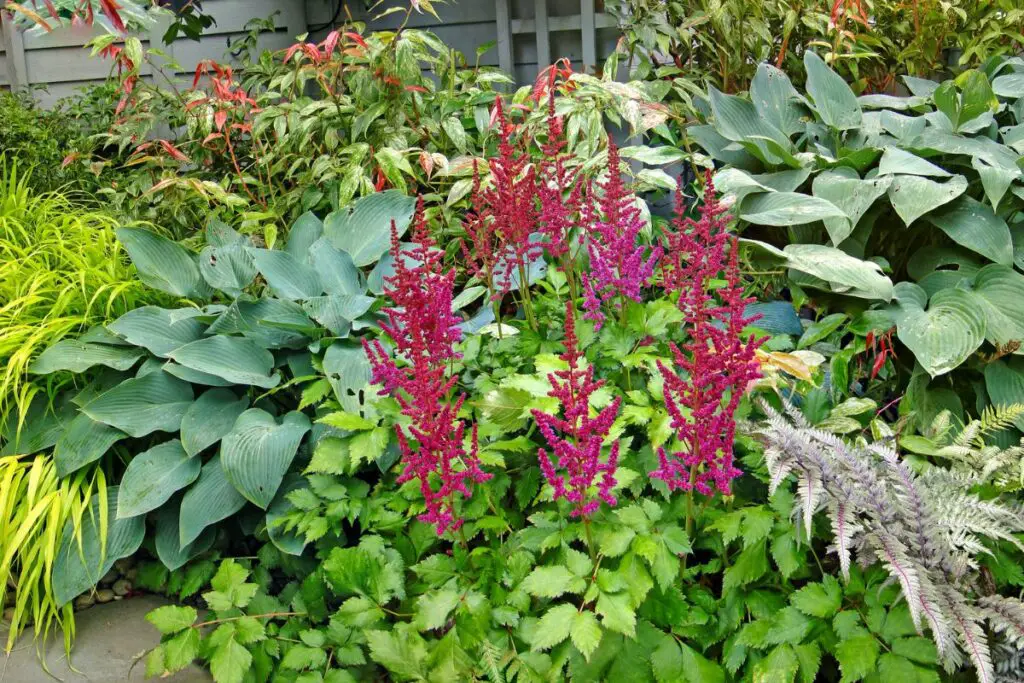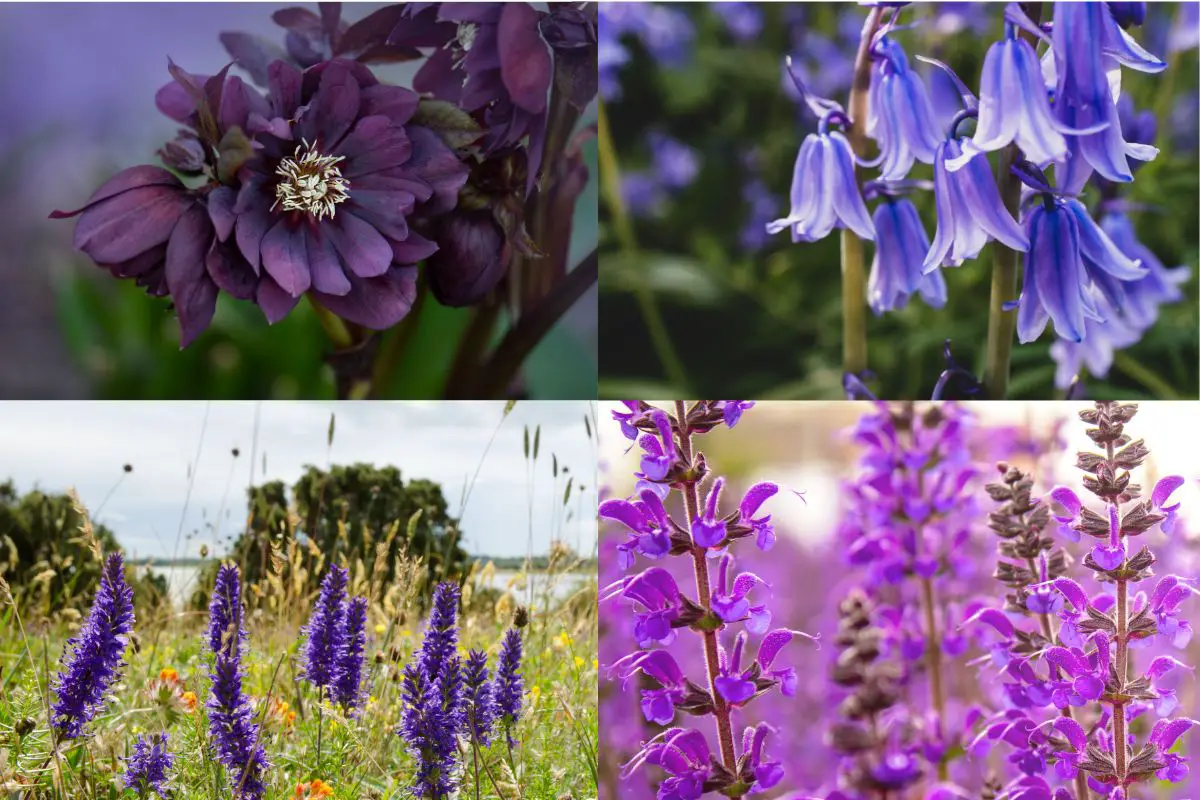When it comes to my garden, purple is one of my favorite colors for perennials. No matter what you have to work with, you can really make a garden pop by adding some purple.
So here is a list of my favorite purple perennials, for your enjoyment, of course!
Table of Contents
Siberian Iris
Siberian iris are a low-maintenance purple perennial that thrives in cool climates. The striking purple blooms appear in late spring on stems that can grow up to 4 feet tall. Siberian iris prefer full sun or part shade and evenly moist soil. Established plants are quite drought-tolerant. Divide clumps every 3-4 years in summer after blooming.
Purple Coneflower
Purple coneflower (Echinacea purpurea) is a classic purple perennial that blooms from early to late summer. The bright flowers feature spiky purple petals surrounding a prominent orange cone. They grow 1-4 feet tall on sturdy stems. Purple coneflower thrives in full sun and average to dry soil. Deadhead spent blooms to encourage more flowers.

Russian Sage
Russian sage is valued for its airy spikes of lavender-purple flowers that add a light, misty color from midsummer into fall. It has grayish-green finely textured foliage that provides a nice contrast to the purple blooms. This tough plant grows 2-4 feet tall in full sun and dry, well-drained soil. Prune back by 1/3 in early spring to promote new growth.
Purple Beautyberry
Purple beautyberry (Callicarpa dichotoma) is a shrub that produces stunning purple berry clusters along arching branches from late summer into fall. It grows 3-5 feet tall in part sun to shade and is very low maintenance once established. Purple beautyberry foliage turns yellow in fall for added seasonal interest.
Purple Dead Nettle
Despite its ominous name, purple dead nettle (Lamium maculatum) adds a carpet of pretty purple blooms in spring and early summer. The low-growing foliage forms a nice ground cover that thrives in shade and moist soil. Purple dead nettle spreads readily, making it a good option for large areas. Cut back after blooming to encourage fresh growth.
Purple Salvia
Purple salvia produces graceful tapering spikes densely packed with tiny violet flowers from late spring until frost. There are many varieties that grow from 1-3 feet tall. Purple salvia thrives in full sun and hot, dry conditions. Remove spent flower spikes to promote new blooms.
Purple Astilbe
Astilbe are valued for their plume-like flowers that bloom in summer. There are many purple varieties to choose from that grow 1-4 feet tall depending on the type. Astilbe do best in partial shade and consistently moist soil enriched with organic matter. Cut back spent flower plumes after blooming.

Purple Speedwell
Purple speedwell (Veronica spicata) is a clump-forming purple perennial that produces long spikes of violet flowers in early summer that sit atop 1-2 foot stems. It thrives in part sun to light shade and average to moist soil. Shear back by half after flowering to encourage fresh growth and blooms.
Feeding 5 Popular Purple Perennials
Here is a look at how to properly feed and care for five of the most popular purple perennial flowers:
| Flower | When to Fertilize | Recommended Fertilizer | Other Care Tips |
|---|---|---|---|
| Purple coneflower | Early spring | Balanced flower fertilizer | Leave seed heads for winter interest and birds |
| Astilbe | Spring and summer | Balanced fertilizer monthly | Prefers consistently moist soil |
| Siberian Iris | Early spring | Balanced flower fertilizer | Divide clumps every 3-4 years |
| Russian Sage | Early spring | Low nitrogen fertilizer | Cut back by 1/3 in early spring |
| Purple Salvia | Spring and midsummer | Balanced flower fertilizer | Remove spent flower spikes |
The Benefits of Purple Perennials
Beyond providing eye-catching color, purple perennials offer many benefits:
- Attract pollinators like bees and butterflies
- Require little care compared to annuals
- Provide interest across seasons
- Fill large areas quickly
- Deliver striking contrast to green foliage
- Come in a diverse range of flower forms
If you’re looking for an easy way to make a big impact with color, purple perennial flowers are a wonderful option for your landscape.
Choosing the Right Purple Perennials
When selecting purple perennials, consider your growing conditions and landscape needs:
- Sun or shade? Pick options suited to sun exposure.
- Moist or dry soil? Look for drought-tolerant choices if dry.
- Bloom time – Choose a mix for nonstop color.
- Height – Vary heights for visual interest.
- Spreading or clump forming? Select spreaders to cover the ground.
With the stunning purple perennial flowers available, you can create a spectacular purple paradise perfectly suited to your unique garden environment.
Combining Purple Perennials with Other Flowers
Purple perennials look beautiful when combined with flowers of contrasting colors. Here are some top companion plants to showcase purple perennials:
- Yellow flowers – Pair purple with yellows like daylilies, coreopsis, and black-eyed Susans for a vibrant contrast.
- White flowers – White blooms like Shasta daisies, astilbe, and baby’s breath make purple pop.
- Blue flowers – Blue complements purple wonderfully. Try campanula, delphiniums, and lobelia.
- Pink or red flowers – Fuchsia, coral bells, and bee balm give purples a pink/red contrast.
- Silver, gray, or green foliage – Dusty miller, artemisia, and succulents make purples shine.
Blending purple perennials with other flower colors creates stunning, dimensional displays.
12 Top Purple Perennial Flowers
Here is an expanded list of 12 of the most popular purple perennial flowers for your landscape:
- Siberian Iris
- Purple Coneflower
- Russian Sage
- Purple Beautyberry
- Purple Dead Nettle
- Purple Salvia
- Purple Astilbe
- Veronica Speedwell
- Lavender
- Purple Mountain Mint
- Catmint
- Purple Coral Bells
This diverse collection provides a wide range of bloom times, heights and growing conditions to fit any garden.
Using Purple Perennials in Garden Beds and Borders
Purple perennials are perfect additions to garden beds and borders:
- Plant in mass for a wave of single color.
- Mix with other colors for texture and contrast.
- Use purple foliage plants like purple barrenwort.
- Include early and late bloomers for ongoing color.
- Vary heights for visual interest and dimension.
With a spectrum of plant forms and hues, purple perennials allow for endless design possibilities.
Container Gardening with Purple Perennials
Many compact purple perennials thrive in containers, making it easy to work purple into patio pots and window boxes:
- Try dwarf lavender, petunias, million bells, salvia.
- Use purple sweet potato vine, purple heart plants and fountain grass as spillers.
- Mix with cool silvery foliage plants like dusty miller.
- Combine with yellow or white flowering annuals.
Get creative combining different purple perennials with cool accent plants in eye-catching containers.
Want to see more colorful perennials? Check out Crepe Myrtle Colors
Purple Perennials for Cottage Gardens
The informal, romantic look of cottage gardens is perfect for showing off purple perennials:
- Plant drifts of purple catmint, coral bells and coneflowers.
- Weave in purple sages, veronica and dead nettle.
- Underplant with purple pansies or violas for color.
- Allow plants to gently self-sow for a natural look.
Purple perennials help create the charming, relaxed vibe that is the hallmark of cottage gardens.
Enjoy the Beauty of Purple Perennials
With their stunning flower colors and easy care nature, purple perennial flowers are sure to bring long-lasting beauty to your landscape. Choose a variety of purple perennials to create eye-catching garden displays that thrive with minimal maintenance.
What’s your favorite purple perennial? Tell us about it in the comments below!

